Human Factors in System Design: Train Ticket Vending Machine Report
VerifiedAdded on 2021/05/31
|25
|5475
|59
Report
AI Summary
This report delves into the human factors involved in the design and usability of an automatic train ticket vending machine. It begins with an introduction to interactive systems and their importance, followed by a description of the specific system, its users, and their capabilities. The report outlines use cases, detailing aspects of system usage and providing descriptions of these cases. The evaluation methodology section discusses the evaluation procedure, user tasks, and debriefing procedures. The evaluation section presents performance and results, including a presentation of findings. The report then summarizes the evaluation results, assesses usability, provides a critical appraisal, and concludes with recommendations for improvement. The report emphasizes the importance of user-friendly interfaces and addresses usability issues such as ticket refunds and the overall ticket-buying experience. The analysis covers various aspects of the ticket vending machine, including the interface, payment methods, and user interactions. The report also highlights the use of heuristic evaluation to identify potential problems and improve the overall user experience.
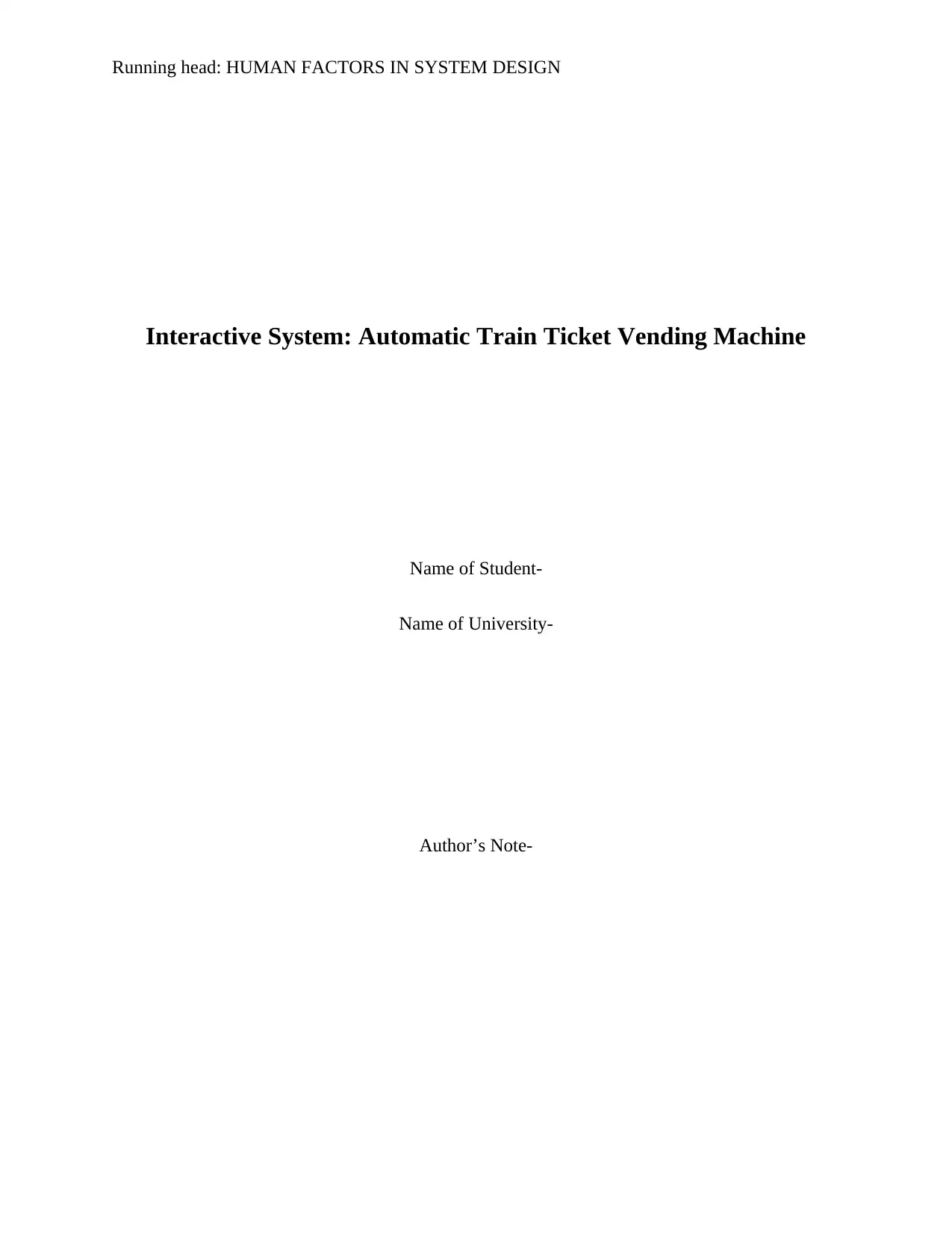
Running head: HUMAN FACTORS IN SYSTEM DESIGN
Interactive System: Automatic Train Ticket Vending Machine
Name of Student-
Name of University-
Author’s Note-
Interactive System: Automatic Train Ticket Vending Machine
Name of Student-
Name of University-
Author’s Note-
Paraphrase This Document
Need a fresh take? Get an instant paraphrase of this document with our AI Paraphraser
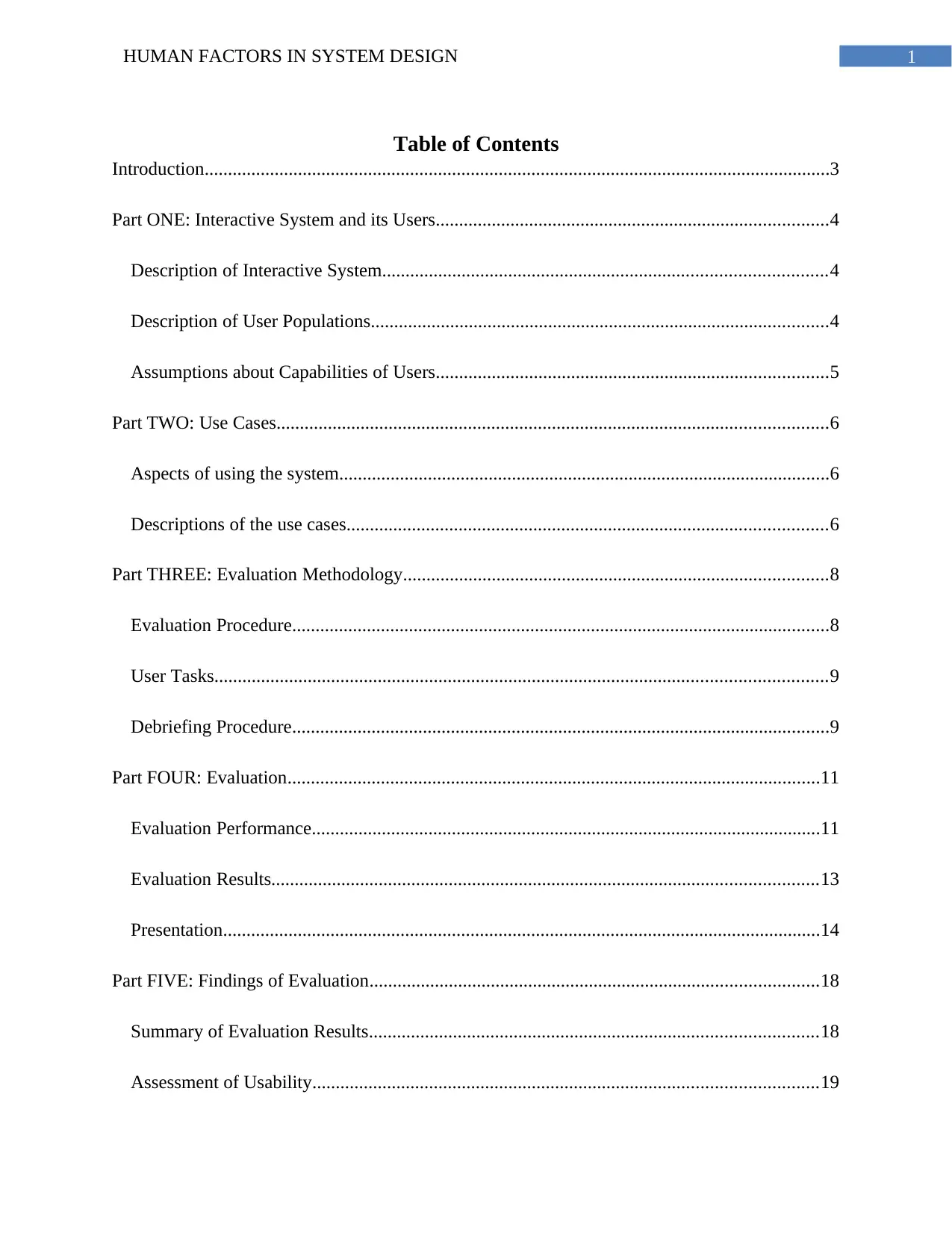
1HUMAN FACTORS IN SYSTEM DESIGN
Table of Contents
Introduction......................................................................................................................................3
Part ONE: Interactive System and its Users....................................................................................4
Description of Interactive System...............................................................................................4
Description of User Populations..................................................................................................4
Assumptions about Capabilities of Users....................................................................................5
Part TWO: Use Cases......................................................................................................................6
Aspects of using the system.........................................................................................................6
Descriptions of the use cases.......................................................................................................6
Part THREE: Evaluation Methodology...........................................................................................8
Evaluation Procedure...................................................................................................................8
User Tasks...................................................................................................................................9
Debriefing Procedure...................................................................................................................9
Part FOUR: Evaluation..................................................................................................................11
Evaluation Performance.............................................................................................................11
Evaluation Results.....................................................................................................................13
Presentation................................................................................................................................14
Part FIVE: Findings of Evaluation................................................................................................18
Summary of Evaluation Results................................................................................................18
Assessment of Usability............................................................................................................19
Table of Contents
Introduction......................................................................................................................................3
Part ONE: Interactive System and its Users....................................................................................4
Description of Interactive System...............................................................................................4
Description of User Populations..................................................................................................4
Assumptions about Capabilities of Users....................................................................................5
Part TWO: Use Cases......................................................................................................................6
Aspects of using the system.........................................................................................................6
Descriptions of the use cases.......................................................................................................6
Part THREE: Evaluation Methodology...........................................................................................8
Evaluation Procedure...................................................................................................................8
User Tasks...................................................................................................................................9
Debriefing Procedure...................................................................................................................9
Part FOUR: Evaluation..................................................................................................................11
Evaluation Performance.............................................................................................................11
Evaluation Results.....................................................................................................................13
Presentation................................................................................................................................14
Part FIVE: Findings of Evaluation................................................................................................18
Summary of Evaluation Results................................................................................................18
Assessment of Usability............................................................................................................19

2HUMAN FACTORS IN SYSTEM DESIGN
Critical Appraisal.......................................................................................................................19
Conclusion.....................................................................................................................................21
Bibliography..................................................................................................................................23
Critical Appraisal.......................................................................................................................19
Conclusion.....................................................................................................................................21
Bibliography..................................................................................................................................23
⊘ This is a preview!⊘
Do you want full access?
Subscribe today to unlock all pages.

Trusted by 1+ million students worldwide
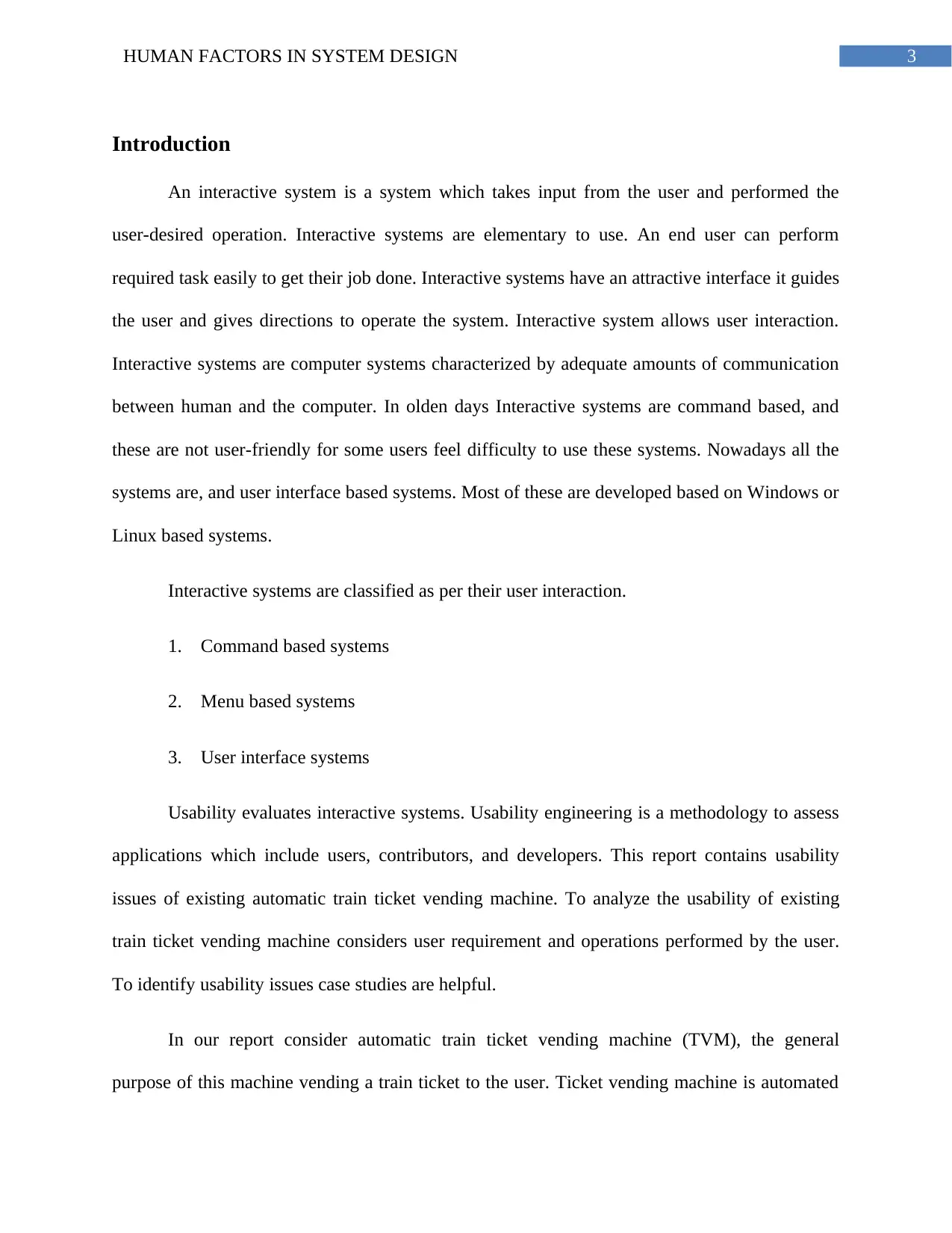
3HUMAN FACTORS IN SYSTEM DESIGN
Introduction
An interactive system is a system which takes input from the user and performed the
user-desired operation. Interactive systems are elementary to use. An end user can perform
required task easily to get their job done. Interactive systems have an attractive interface it guides
the user and gives directions to operate the system. Interactive system allows user interaction.
Interactive systems are computer systems characterized by adequate amounts of communication
between human and the computer. In olden days Interactive systems are command based, and
these are not user-friendly for some users feel difficulty to use these systems. Nowadays all the
systems are, and user interface based systems. Most of these are developed based on Windows or
Linux based systems.
Interactive systems are classified as per their user interaction.
1. Command based systems
2. Menu based systems
3. User interface systems
Usability evaluates interactive systems. Usability engineering is a methodology to assess
applications which include users, contributors, and developers. This report contains usability
issues of existing automatic train ticket vending machine. To analyze the usability of existing
train ticket vending machine considers user requirement and operations performed by the user.
To identify usability issues case studies are helpful.
In our report consider automatic train ticket vending machine (TVM), the general
purpose of this machine vending a train ticket to the user. Ticket vending machine is automated
Introduction
An interactive system is a system which takes input from the user and performed the
user-desired operation. Interactive systems are elementary to use. An end user can perform
required task easily to get their job done. Interactive systems have an attractive interface it guides
the user and gives directions to operate the system. Interactive system allows user interaction.
Interactive systems are computer systems characterized by adequate amounts of communication
between human and the computer. In olden days Interactive systems are command based, and
these are not user-friendly for some users feel difficulty to use these systems. Nowadays all the
systems are, and user interface based systems. Most of these are developed based on Windows or
Linux based systems.
Interactive systems are classified as per their user interaction.
1. Command based systems
2. Menu based systems
3. User interface systems
Usability evaluates interactive systems. Usability engineering is a methodology to assess
applications which include users, contributors, and developers. This report contains usability
issues of existing automatic train ticket vending machine. To analyze the usability of existing
train ticket vending machine considers user requirement and operations performed by the user.
To identify usability issues case studies are helpful.
In our report consider automatic train ticket vending machine (TVM), the general
purpose of this machine vending a train ticket to the user. Ticket vending machine is automated
Paraphrase This Document
Need a fresh take? Get an instant paraphrase of this document with our AI Paraphraser
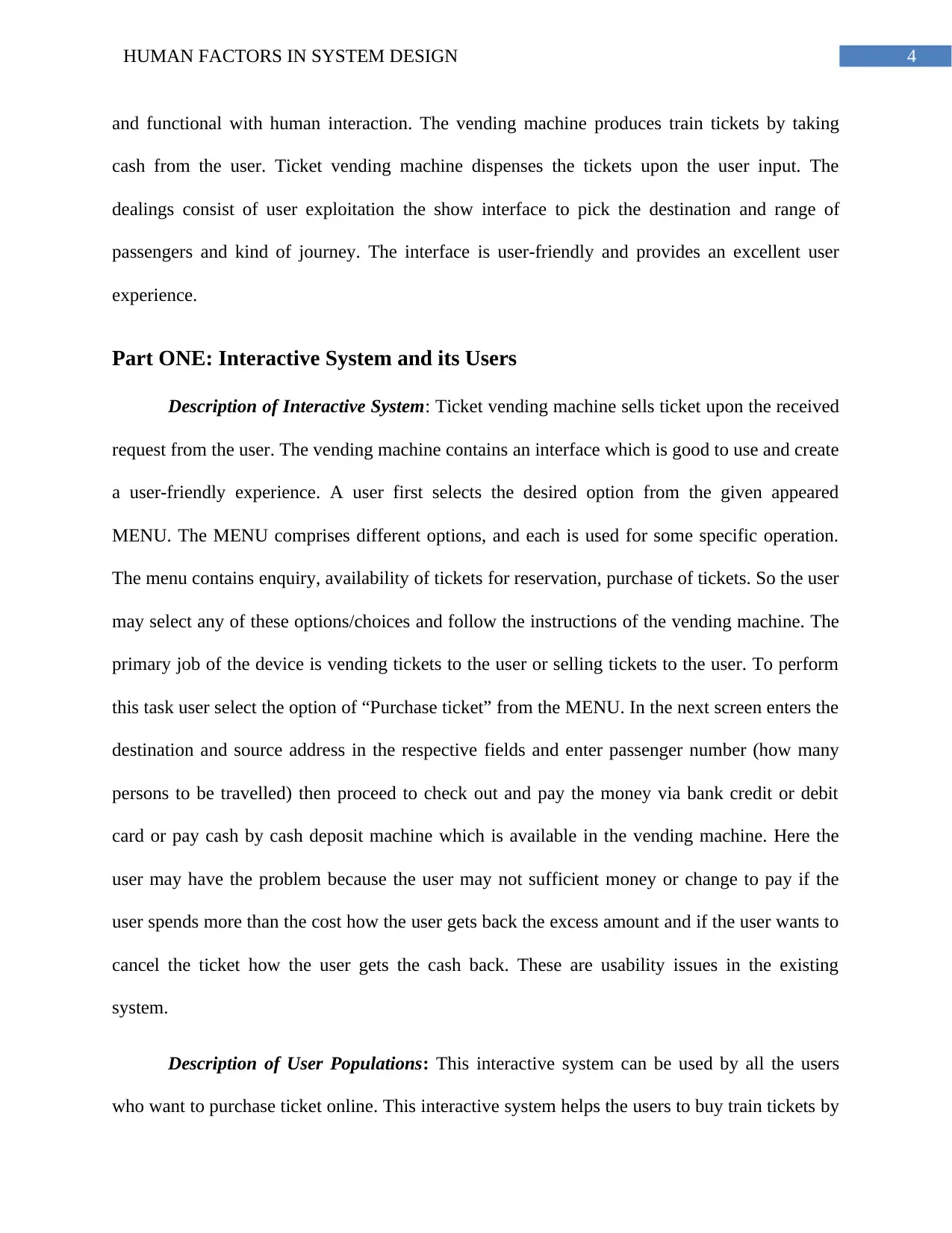
4HUMAN FACTORS IN SYSTEM DESIGN
and functional with human interaction. The vending machine produces train tickets by taking
cash from the user. Ticket vending machine dispenses the tickets upon the user input. The
dealings consist of user exploitation the show interface to pick the destination and range of
passengers and kind of journey. The interface is user-friendly and provides an excellent user
experience.
Part ONE: Interactive System and its Users
Description of Interactive System: Ticket vending machine sells ticket upon the received
request from the user. The vending machine contains an interface which is good to use and create
a user-friendly experience. A user first selects the desired option from the given appeared
MENU. The MENU comprises different options, and each is used for some specific operation.
The menu contains enquiry, availability of tickets for reservation, purchase of tickets. So the user
may select any of these options/choices and follow the instructions of the vending machine. The
primary job of the device is vending tickets to the user or selling tickets to the user. To perform
this task user select the option of “Purchase ticket” from the MENU. In the next screen enters the
destination and source address in the respective fields and enter passenger number (how many
persons to be travelled) then proceed to check out and pay the money via bank credit or debit
card or pay cash by cash deposit machine which is available in the vending machine. Here the
user may have the problem because the user may not sufficient money or change to pay if the
user spends more than the cost how the user gets back the excess amount and if the user wants to
cancel the ticket how the user gets the cash back. These are usability issues in the existing
system.
Description of User Populations: This interactive system can be used by all the users
who want to purchase ticket online. This interactive system helps the users to buy train tickets by
and functional with human interaction. The vending machine produces train tickets by taking
cash from the user. Ticket vending machine dispenses the tickets upon the user input. The
dealings consist of user exploitation the show interface to pick the destination and range of
passengers and kind of journey. The interface is user-friendly and provides an excellent user
experience.
Part ONE: Interactive System and its Users
Description of Interactive System: Ticket vending machine sells ticket upon the received
request from the user. The vending machine contains an interface which is good to use and create
a user-friendly experience. A user first selects the desired option from the given appeared
MENU. The MENU comprises different options, and each is used for some specific operation.
The menu contains enquiry, availability of tickets for reservation, purchase of tickets. So the user
may select any of these options/choices and follow the instructions of the vending machine. The
primary job of the device is vending tickets to the user or selling tickets to the user. To perform
this task user select the option of “Purchase ticket” from the MENU. In the next screen enters the
destination and source address in the respective fields and enter passenger number (how many
persons to be travelled) then proceed to check out and pay the money via bank credit or debit
card or pay cash by cash deposit machine which is available in the vending machine. Here the
user may have the problem because the user may not sufficient money or change to pay if the
user spends more than the cost how the user gets back the excess amount and if the user wants to
cancel the ticket how the user gets the cash back. These are usability issues in the existing
system.
Description of User Populations: This interactive system can be used by all the users
who want to purchase ticket online. This interactive system helps the users to buy train tickets by
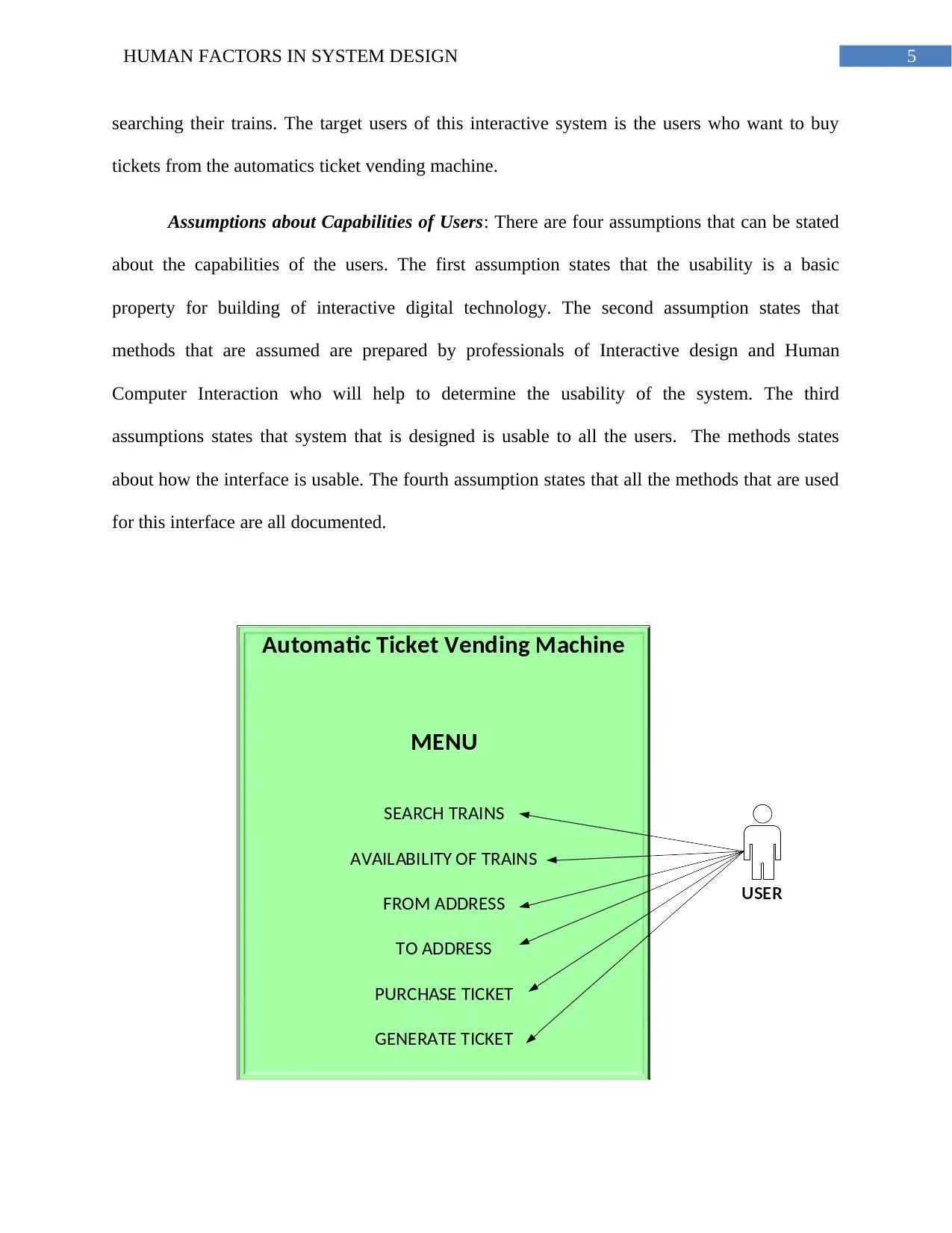
5HUMAN FACTORS IN SYSTEM DESIGN
searching their trains. The target users of this interactive system is the users who want to buy
tickets from the automatics ticket vending machine.
Assumptions about Capabilities of Users: There are four assumptions that can be stated
about the capabilities of the users. The first assumption states that the usability is a basic
property for building of interactive digital technology. The second assumption states that
methods that are assumed are prepared by professionals of Interactive design and Human
Computer Interaction who will help to determine the usability of the system. The third
assumptions states that system that is designed is usable to all the users. The methods states
about how the interface is usable. The fourth assumption states that all the methods that are used
for this interface are all documented.
searching their trains. The target users of this interactive system is the users who want to buy
tickets from the automatics ticket vending machine.
Assumptions about Capabilities of Users: There are four assumptions that can be stated
about the capabilities of the users. The first assumption states that the usability is a basic
property for building of interactive digital technology. The second assumption states that
methods that are assumed are prepared by professionals of Interactive design and Human
Computer Interaction who will help to determine the usability of the system. The third
assumptions states that system that is designed is usable to all the users. The methods states
about how the interface is usable. The fourth assumption states that all the methods that are used
for this interface are all documented.
⊘ This is a preview!⊘
Do you want full access?
Subscribe today to unlock all pages.

Trusted by 1+ million students worldwide
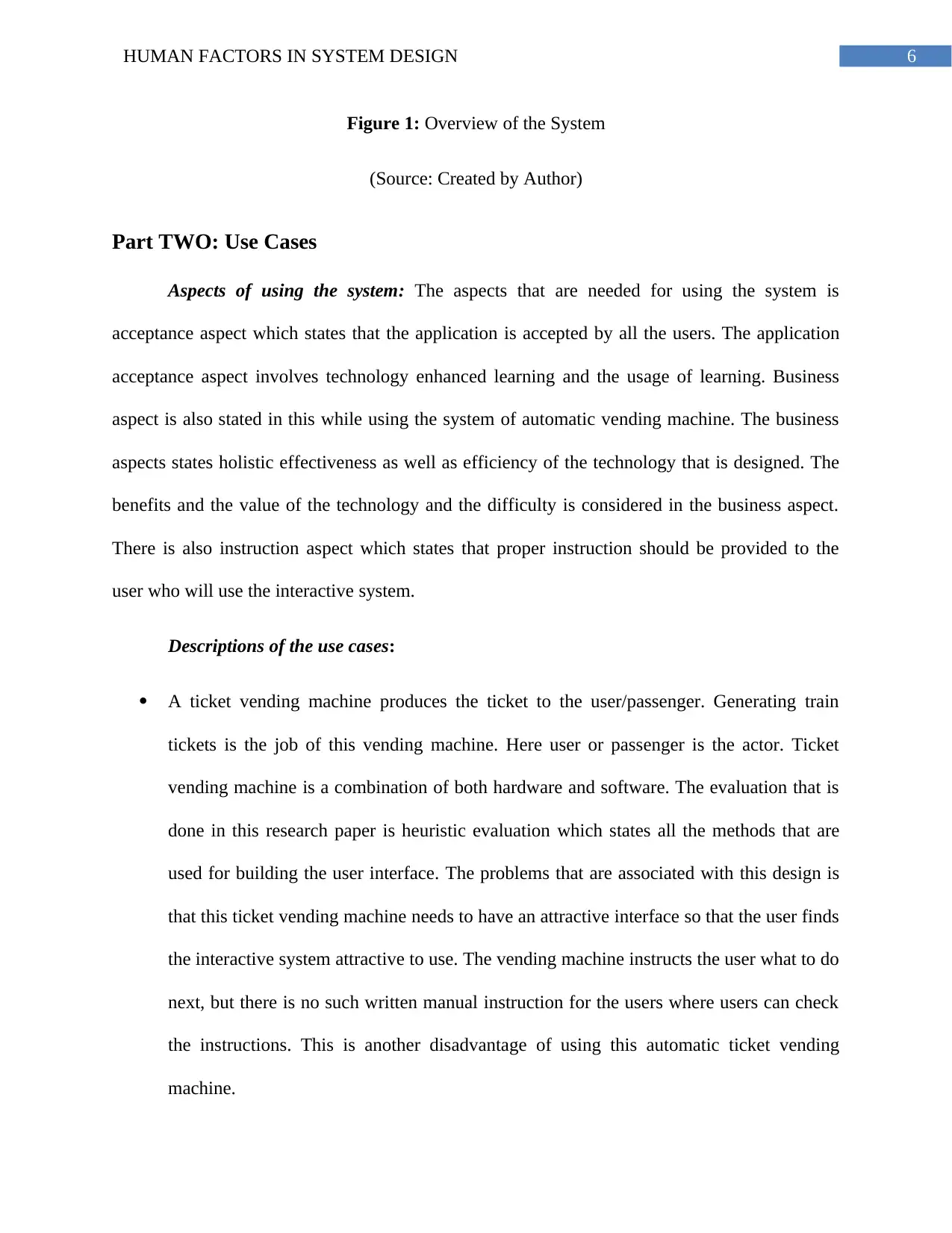
6HUMAN FACTORS IN SYSTEM DESIGN
Figure 1: Overview of the System
(Source: Created by Author)
Part TWO: Use Cases
Aspects of using the system: The aspects that are needed for using the system is
acceptance aspect which states that the application is accepted by all the users. The application
acceptance aspect involves technology enhanced learning and the usage of learning. Business
aspect is also stated in this while using the system of automatic vending machine. The business
aspects states holistic effectiveness as well as efficiency of the technology that is designed. The
benefits and the value of the technology and the difficulty is considered in the business aspect.
There is also instruction aspect which states that proper instruction should be provided to the
user who will use the interactive system.
Descriptions of the use cases:
A ticket vending machine produces the ticket to the user/passenger. Generating train
tickets is the job of this vending machine. Here user or passenger is the actor. Ticket
vending machine is a combination of both hardware and software. The evaluation that is
done in this research paper is heuristic evaluation which states all the methods that are
used for building the user interface. The problems that are associated with this design is
that this ticket vending machine needs to have an attractive interface so that the user finds
the interactive system attractive to use. The vending machine instructs the user what to do
next, but there is no such written manual instruction for the users where users can check
the instructions. This is another disadvantage of using this automatic ticket vending
machine.
Figure 1: Overview of the System
(Source: Created by Author)
Part TWO: Use Cases
Aspects of using the system: The aspects that are needed for using the system is
acceptance aspect which states that the application is accepted by all the users. The application
acceptance aspect involves technology enhanced learning and the usage of learning. Business
aspect is also stated in this while using the system of automatic vending machine. The business
aspects states holistic effectiveness as well as efficiency of the technology that is designed. The
benefits and the value of the technology and the difficulty is considered in the business aspect.
There is also instruction aspect which states that proper instruction should be provided to the
user who will use the interactive system.
Descriptions of the use cases:
A ticket vending machine produces the ticket to the user/passenger. Generating train
tickets is the job of this vending machine. Here user or passenger is the actor. Ticket
vending machine is a combination of both hardware and software. The evaluation that is
done in this research paper is heuristic evaluation which states all the methods that are
used for building the user interface. The problems that are associated with this design is
that this ticket vending machine needs to have an attractive interface so that the user finds
the interactive system attractive to use. The vending machine instructs the user what to do
next, but there is no such written manual instruction for the users where users can check
the instructions. This is another disadvantage of using this automatic ticket vending
machine.
Paraphrase This Document
Need a fresh take? Get an instant paraphrase of this document with our AI Paraphraser
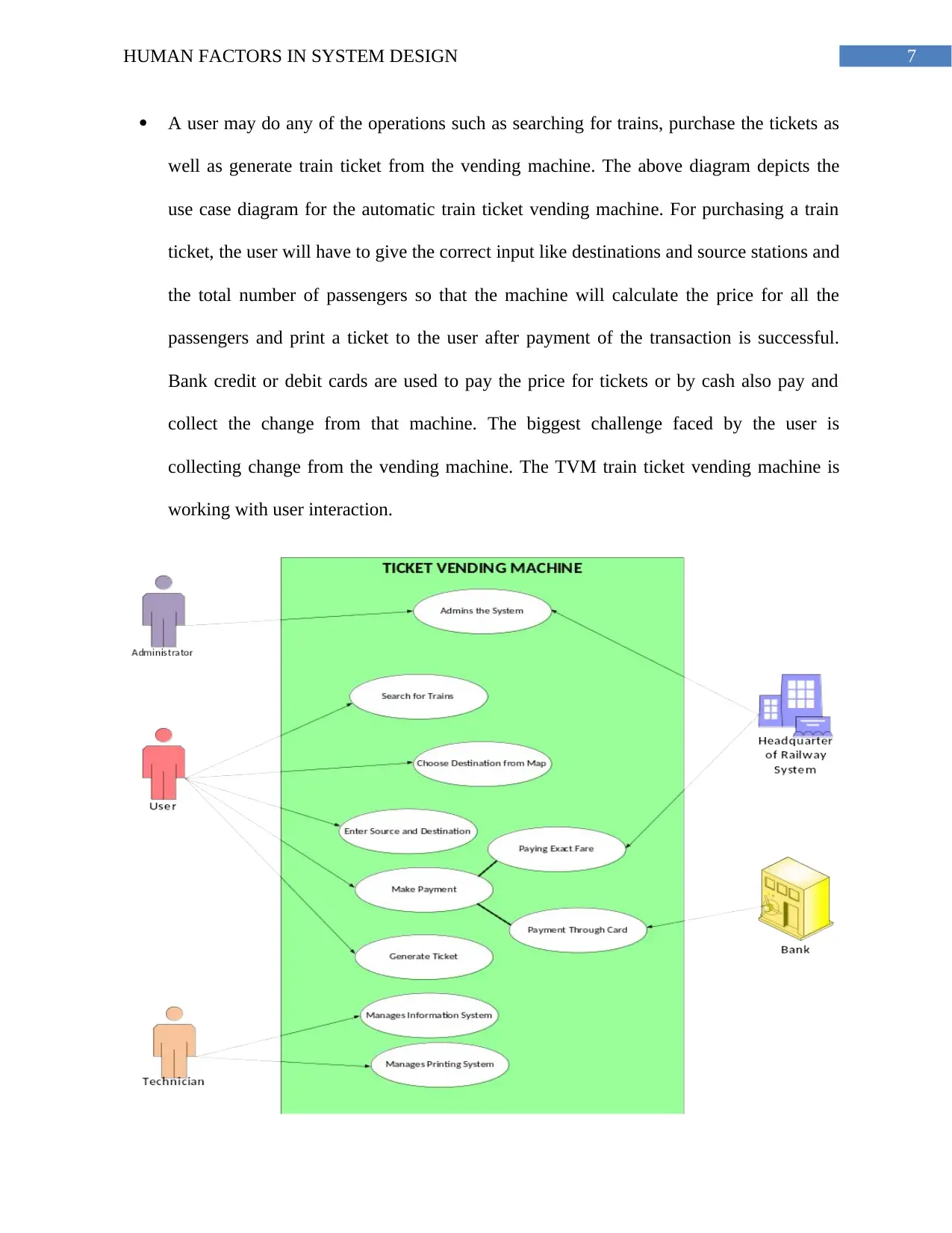
7HUMAN FACTORS IN SYSTEM DESIGN
A user may do any of the operations such as searching for trains, purchase the tickets as
well as generate train ticket from the vending machine. The above diagram depicts the
use case diagram for the automatic train ticket vending machine. For purchasing a train
ticket, the user will have to give the correct input like destinations and source stations and
the total number of passengers so that the machine will calculate the price for all the
passengers and print a ticket to the user after payment of the transaction is successful.
Bank credit or debit cards are used to pay the price for tickets or by cash also pay and
collect the change from that machine. The biggest challenge faced by the user is
collecting change from the vending machine. The TVM train ticket vending machine is
working with user interaction.
A user may do any of the operations such as searching for trains, purchase the tickets as
well as generate train ticket from the vending machine. The above diagram depicts the
use case diagram for the automatic train ticket vending machine. For purchasing a train
ticket, the user will have to give the correct input like destinations and source stations and
the total number of passengers so that the machine will calculate the price for all the
passengers and print a ticket to the user after payment of the transaction is successful.
Bank credit or debit cards are used to pay the price for tickets or by cash also pay and
collect the change from that machine. The biggest challenge faced by the user is
collecting change from the vending machine. The TVM train ticket vending machine is
working with user interaction.

8HUMAN FACTORS IN SYSTEM DESIGN
Figure 2: Use Case of Ticket Vending Machine
(Source: Created by Author)
Admin can perform only operations managing and monitoring the whole system.
The ticket vending machine also has a technician who look after the information system
of the ticket machine. He looks after if any part pf the system is not working. The technician also
looks after the printing system of ticket whether there is paper present in the system or not.
Ticket merchandising machines (TVMs) ought to give passengers with the chance to
create fast and straightforward rail price ticket purchases at stations. There are concerns that the
quality of information provided to passengers using TVMs is insufficient to enable them to make
purchasing decisions appropriate to their journey needs. The use case diagram of the automated
ticket vending machine is shown above.
Part THREE: Evaluation Methodology
Evaluation Procedure: There are mainly three evaluation procedure that can be stated for
evaluation. There is Heuristic Evaluation, Think Aloud Evaluation, and Pluralistic Evaluation.
For carrying out this research study, Heuristic evaluation is carried out in which the research
goes through different scenarios and tries to find out the errors that are based on the rule of
Heuristic Evaluation. The rules that are involved in Heuristic Evaluation is visibility of the
system status. In Heuristic Evaluation, it is also searched that the system that is designed matches
between the system and the real world. Heuristic Evaluation should also have user control and
have freedom for accessing the system. The errors that are found in the system should have the
prevention methods where the system is capable of handling all the errors involved in the
application. There should be flexibility and there should be efficiency for using the application.
Figure 2: Use Case of Ticket Vending Machine
(Source: Created by Author)
Admin can perform only operations managing and monitoring the whole system.
The ticket vending machine also has a technician who look after the information system
of the ticket machine. He looks after if any part pf the system is not working. The technician also
looks after the printing system of ticket whether there is paper present in the system or not.
Ticket merchandising machines (TVMs) ought to give passengers with the chance to
create fast and straightforward rail price ticket purchases at stations. There are concerns that the
quality of information provided to passengers using TVMs is insufficient to enable them to make
purchasing decisions appropriate to their journey needs. The use case diagram of the automated
ticket vending machine is shown above.
Part THREE: Evaluation Methodology
Evaluation Procedure: There are mainly three evaluation procedure that can be stated for
evaluation. There is Heuristic Evaluation, Think Aloud Evaluation, and Pluralistic Evaluation.
For carrying out this research study, Heuristic evaluation is carried out in which the research
goes through different scenarios and tries to find out the errors that are based on the rule of
Heuristic Evaluation. The rules that are involved in Heuristic Evaluation is visibility of the
system status. In Heuristic Evaluation, it is also searched that the system that is designed matches
between the system and the real world. Heuristic Evaluation should also have user control and
have freedom for accessing the system. The errors that are found in the system should have the
prevention methods where the system is capable of handling all the errors involved in the
application. There should be flexibility and there should be efficiency for using the application.
⊘ This is a preview!⊘
Do you want full access?
Subscribe today to unlock all pages.

Trusted by 1+ million students worldwide
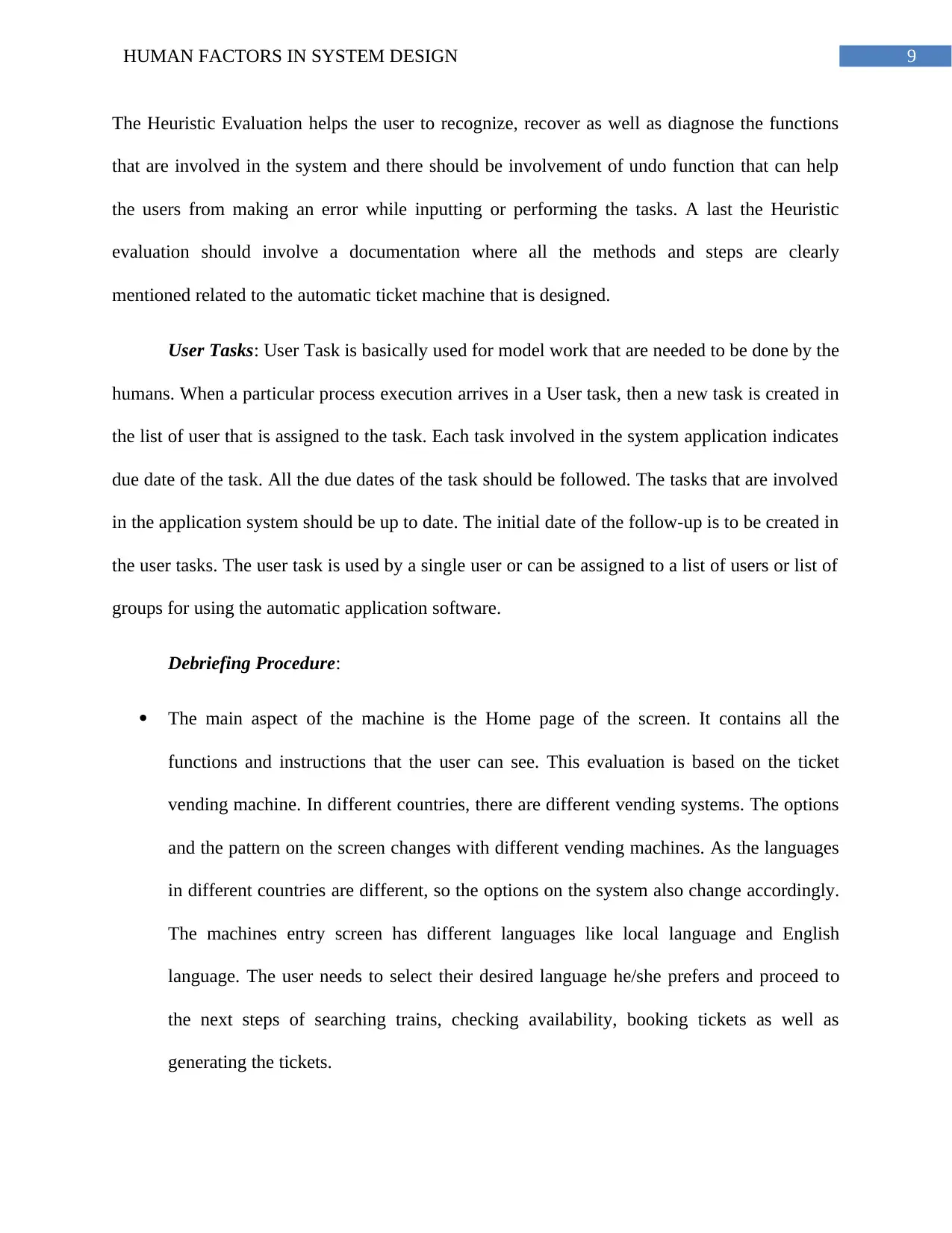
9HUMAN FACTORS IN SYSTEM DESIGN
The Heuristic Evaluation helps the user to recognize, recover as well as diagnose the functions
that are involved in the system and there should be involvement of undo function that can help
the users from making an error while inputting or performing the tasks. A last the Heuristic
evaluation should involve a documentation where all the methods and steps are clearly
mentioned related to the automatic ticket machine that is designed.
User Tasks: User Task is basically used for model work that are needed to be done by the
humans. When a particular process execution arrives in a User task, then a new task is created in
the list of user that is assigned to the task. Each task involved in the system application indicates
due date of the task. All the due dates of the task should be followed. The tasks that are involved
in the application system should be up to date. The initial date of the follow-up is to be created in
the user tasks. The user task is used by a single user or can be assigned to a list of users or list of
groups for using the automatic application software.
Debriefing Procedure:
The main aspect of the machine is the Home page of the screen. It contains all the
functions and instructions that the user can see. This evaluation is based on the ticket
vending machine. In different countries, there are different vending systems. The options
and the pattern on the screen changes with different vending machines. As the languages
in different countries are different, so the options on the system also change accordingly.
The machines entry screen has different languages like local language and English
language. The user needs to select their desired language he/she prefers and proceed to
the next steps of searching trains, checking availability, booking tickets as well as
generating the tickets.
The Heuristic Evaluation helps the user to recognize, recover as well as diagnose the functions
that are involved in the system and there should be involvement of undo function that can help
the users from making an error while inputting or performing the tasks. A last the Heuristic
evaluation should involve a documentation where all the methods and steps are clearly
mentioned related to the automatic ticket machine that is designed.
User Tasks: User Task is basically used for model work that are needed to be done by the
humans. When a particular process execution arrives in a User task, then a new task is created in
the list of user that is assigned to the task. Each task involved in the system application indicates
due date of the task. All the due dates of the task should be followed. The tasks that are involved
in the application system should be up to date. The initial date of the follow-up is to be created in
the user tasks. The user task is used by a single user or can be assigned to a list of users or list of
groups for using the automatic application software.
Debriefing Procedure:
The main aspect of the machine is the Home page of the screen. It contains all the
functions and instructions that the user can see. This evaluation is based on the ticket
vending machine. In different countries, there are different vending systems. The options
and the pattern on the screen changes with different vending machines. As the languages
in different countries are different, so the options on the system also change accordingly.
The machines entry screen has different languages like local language and English
language. The user needs to select their desired language he/she prefers and proceed to
the next steps of searching trains, checking availability, booking tickets as well as
generating the tickets.
Paraphrase This Document
Need a fresh take? Get an instant paraphrase of this document with our AI Paraphraser
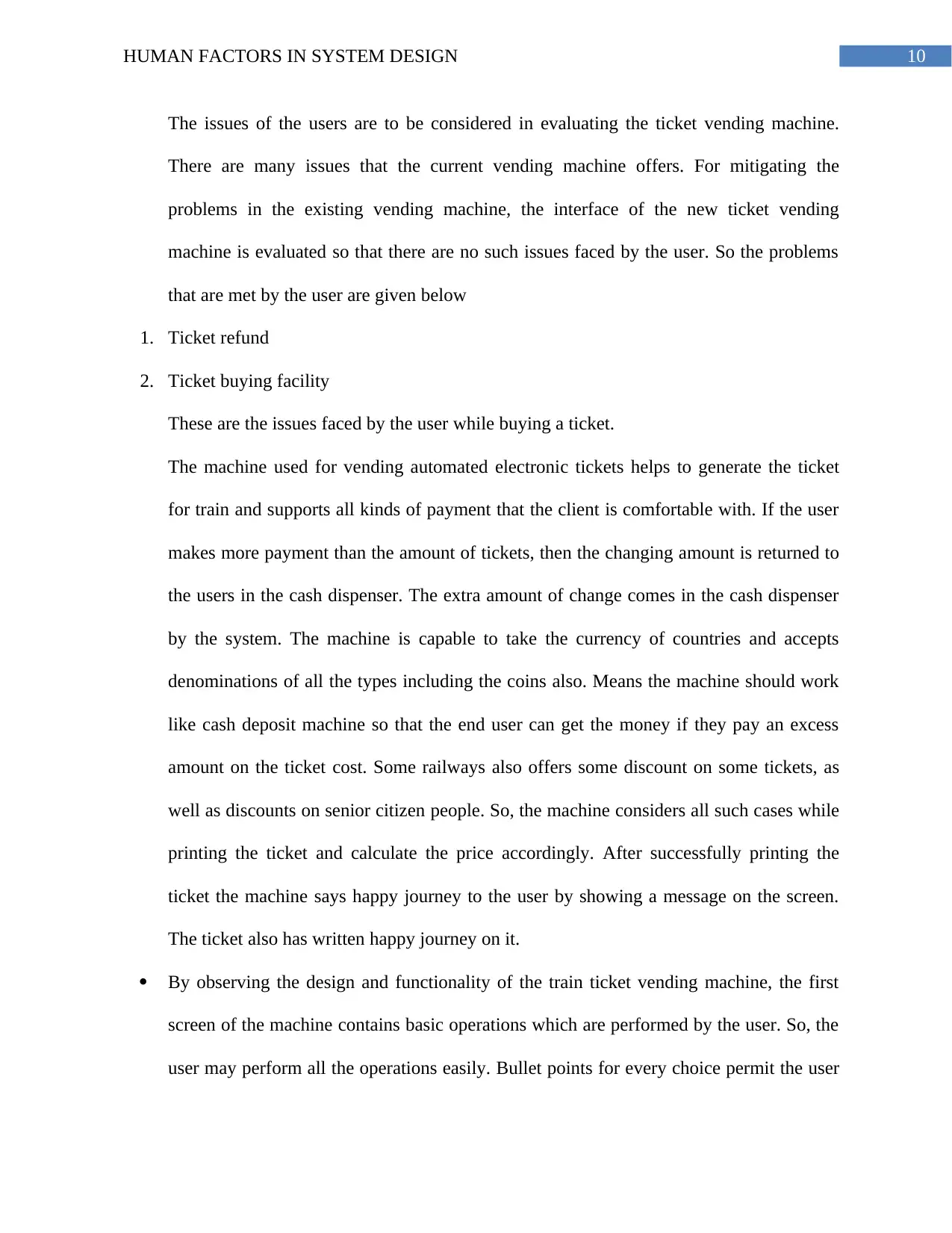
10HUMAN FACTORS IN SYSTEM DESIGN
The issues of the users are to be considered in evaluating the ticket vending machine.
There are many issues that the current vending machine offers. For mitigating the
problems in the existing vending machine, the interface of the new ticket vending
machine is evaluated so that there are no such issues faced by the user. So the problems
that are met by the user are given below
1. Ticket refund
2. Ticket buying facility
These are the issues faced by the user while buying a ticket.
The machine used for vending automated electronic tickets helps to generate the ticket
for train and supports all kinds of payment that the client is comfortable with. If the user
makes more payment than the amount of tickets, then the changing amount is returned to
the users in the cash dispenser. The extra amount of change comes in the cash dispenser
by the system. The machine is capable to take the currency of countries and accepts
denominations of all the types including the coins also. Means the machine should work
like cash deposit machine so that the end user can get the money if they pay an excess
amount on the ticket cost. Some railways also offers some discount on some tickets, as
well as discounts on senior citizen people. So, the machine considers all such cases while
printing the ticket and calculate the price accordingly. After successfully printing the
ticket the machine says happy journey to the user by showing a message on the screen.
The ticket also has written happy journey on it.
By observing the design and functionality of the train ticket vending machine, the first
screen of the machine contains basic operations which are performed by the user. So, the
user may perform all the operations easily. Bullet points for every choice permit the user
The issues of the users are to be considered in evaluating the ticket vending machine.
There are many issues that the current vending machine offers. For mitigating the
problems in the existing vending machine, the interface of the new ticket vending
machine is evaluated so that there are no such issues faced by the user. So the problems
that are met by the user are given below
1. Ticket refund
2. Ticket buying facility
These are the issues faced by the user while buying a ticket.
The machine used for vending automated electronic tickets helps to generate the ticket
for train and supports all kinds of payment that the client is comfortable with. If the user
makes more payment than the amount of tickets, then the changing amount is returned to
the users in the cash dispenser. The extra amount of change comes in the cash dispenser
by the system. The machine is capable to take the currency of countries and accepts
denominations of all the types including the coins also. Means the machine should work
like cash deposit machine so that the end user can get the money if they pay an excess
amount on the ticket cost. Some railways also offers some discount on some tickets, as
well as discounts on senior citizen people. So, the machine considers all such cases while
printing the ticket and calculate the price accordingly. After successfully printing the
ticket the machine says happy journey to the user by showing a message on the screen.
The ticket also has written happy journey on it.
By observing the design and functionality of the train ticket vending machine, the first
screen of the machine contains basic operations which are performed by the user. So, the
user may perform all the operations easily. Bullet points for every choice permit the user
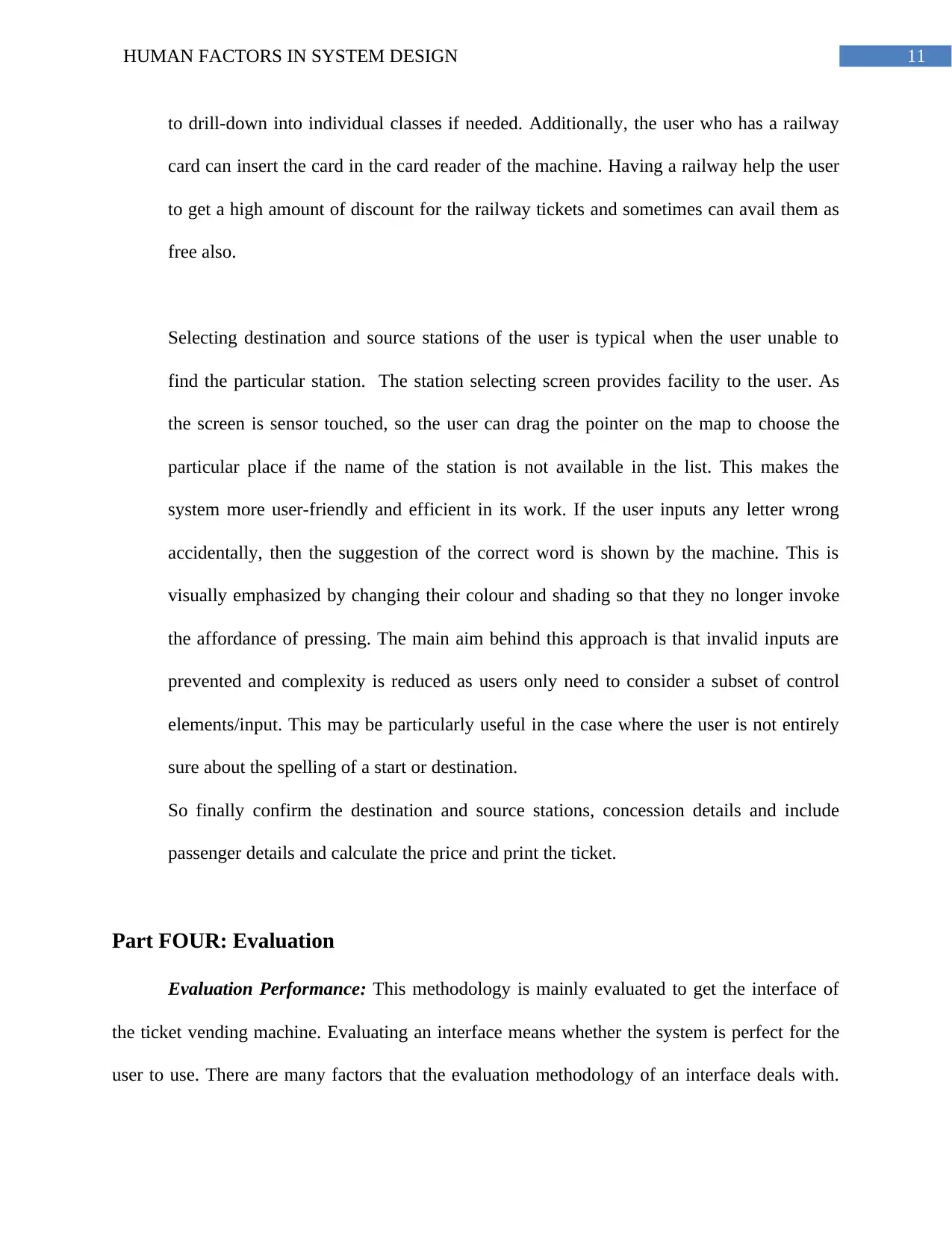
11HUMAN FACTORS IN SYSTEM DESIGN
to drill-down into individual classes if needed. Additionally, the user who has a railway
card can insert the card in the card reader of the machine. Having a railway help the user
to get a high amount of discount for the railway tickets and sometimes can avail them as
free also.
Selecting destination and source stations of the user is typical when the user unable to
find the particular station. The station selecting screen provides facility to the user. As
the screen is sensor touched, so the user can drag the pointer on the map to choose the
particular place if the name of the station is not available in the list. This makes the
system more user-friendly and efficient in its work. If the user inputs any letter wrong
accidentally, then the suggestion of the correct word is shown by the machine. This is
visually emphasized by changing their colour and shading so that they no longer invoke
the affordance of pressing. The main aim behind this approach is that invalid inputs are
prevented and complexity is reduced as users only need to consider a subset of control
elements/input. This may be particularly useful in the case where the user is not entirely
sure about the spelling of a start or destination.
So finally confirm the destination and source stations, concession details and include
passenger details and calculate the price and print the ticket.
Part FOUR: Evaluation
Evaluation Performance: This methodology is mainly evaluated to get the interface of
the ticket vending machine. Evaluating an interface means whether the system is perfect for the
user to use. There are many factors that the evaluation methodology of an interface deals with.
to drill-down into individual classes if needed. Additionally, the user who has a railway
card can insert the card in the card reader of the machine. Having a railway help the user
to get a high amount of discount for the railway tickets and sometimes can avail them as
free also.
Selecting destination and source stations of the user is typical when the user unable to
find the particular station. The station selecting screen provides facility to the user. As
the screen is sensor touched, so the user can drag the pointer on the map to choose the
particular place if the name of the station is not available in the list. This makes the
system more user-friendly and efficient in its work. If the user inputs any letter wrong
accidentally, then the suggestion of the correct word is shown by the machine. This is
visually emphasized by changing their colour and shading so that they no longer invoke
the affordance of pressing. The main aim behind this approach is that invalid inputs are
prevented and complexity is reduced as users only need to consider a subset of control
elements/input. This may be particularly useful in the case where the user is not entirely
sure about the spelling of a start or destination.
So finally confirm the destination and source stations, concession details and include
passenger details and calculate the price and print the ticket.
Part FOUR: Evaluation
Evaluation Performance: This methodology is mainly evaluated to get the interface of
the ticket vending machine. Evaluating an interface means whether the system is perfect for the
user to use. There are many factors that the evaluation methodology of an interface deals with.
⊘ This is a preview!⊘
Do you want full access?
Subscribe today to unlock all pages.

Trusted by 1+ million students worldwide
1 out of 25
Related Documents
Your All-in-One AI-Powered Toolkit for Academic Success.
+13062052269
info@desklib.com
Available 24*7 on WhatsApp / Email
![[object Object]](/_next/static/media/star-bottom.7253800d.svg)
Unlock your academic potential
Copyright © 2020–2025 A2Z Services. All Rights Reserved. Developed and managed by ZUCOL.





